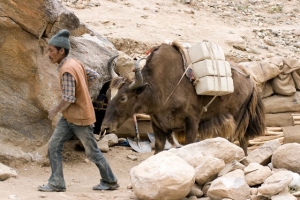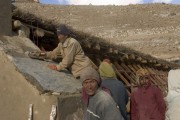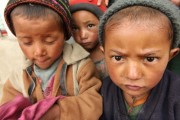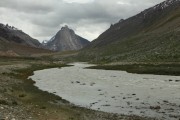White Gold of the Himalayas, nomad life, wolfs and snow leopards
 Dear followers of this website, Adam and David are yet again reporting from Kargyak village in remote Zanskar valley. This time we are here to introduce the life of Doksa and surrounding areas were we spend our free time when possible. But firstly, what is Doksa? Simply said, it is more traditional form of a farm (...)
Dear followers of this website, Adam and David are yet again reporting from Kargyak village in remote Zanskar valley. This time we are here to introduce the life of Doksa and surrounding areas were we spend our free time when possible. But firstly, what is Doksa? Simply said, it is more traditional form of a farm (...)
Simply said, it is more traditional form of a farm as you may know from Europe.
Rather than breeding cows and pigs, you can find here yaks, goats and sheep.
Instead of producing hay locals produce dry yak dunk. Rather than keeping all
animals in fenced areas all animals are run freely, which makes Doksa life
quite tough. Just take in account the migration for fresh pasture. Location of Doksa changes every 4 weeks and
is planned for the whole year in agreement with other villages. Almost everyone
in Kargyak has some cattle and therefore every family has a dedicated member
who looks after their yaks in doksa. Doksa people are no longer nomads as they
used to be, instead these people are being pushed to the boundaries of society
and only very few lucky ones manage to gain basic skills of writing and
reading. Specially these days hardly anyone wants to go and wander for months
with rest of doksa on steep pastures of Himalaya and maybe that is the reason
why most of local nomads changed to semi-nomads that stay at home over winter
and use the basic stone and leather made shelters high in the mountains over
the summer while migrating for pastures.
Local
‘’milk factory’’ is made of stone piles and leather, surrounded by big herds of
yaks wandering around seeking some delicious and precious green grass. This
place is not only a place to produce “white gold”. With bit of sarcasm, we can
say it is a factory for happiness and joy. Life here is so simple with wide
selection of delicious diary, warm-hearted people and almost no trouble. Well
if you ignore the moments when some yak stumps on your feet or when you are hit
by a rolling stone or when you are on a guard duty for wolves in the middle of
deep night. Recent years have shown overcrowded packs of wolves and that make
it a bit of challenge. The good side of the thing is the fact that wolves are
afraid of humans, but this is not a case of snow leopards. And it was only a
year ago when one of these almost extinct predators lost his battle with
villagers. And if you think that its death became reason for the villagers to
celebrate you are wrong… Anyway if wolfs are unsuccessful they have to leave
doksa and keep looking for something else to eat, which is even harder especially
after winter and in this mountain
desert. One of their potential preys Marmots are very common for this region. These
small mammals are quite witty, especially with their system of underground
tunnels. It takes lot of energy for wolfs to get one of those for snack. Indeed,
they can try to catch some young ibex o argali, but so far doksa is still the
easiest source of food, particularly small yaks. Local people say that if these
wolfs are put on the edge of starvation they can even kill the mighty snow
leopard. Nature always finds its solution to survive. We shall follow the rules
as well. So, that’s it for today. So far, so good.
AD

 In now days are hppening big changes in Jammu and Kashmir.
https://www.bbc.com/news/world/asia/india
In now days are hppening big changes in Jammu and Kashmir.
https://www.bbc.com/news/world/asia/india  On September 21st, Kargyak Sun School will celebrate the 10th anniversary of its opening. There, in one of the last places on Earth, the original Tibetan culture survives at the elevation of 4200 m. Before the school opened, the village of 200 heads had only 10 members who could read and write a little. To get an education, children were sent away to boarding schools in faraway towns. Today, the Sun School has its alumni and thanks to the project, people stopped moving away from the village.
On September 21st, Kargyak Sun School will celebrate the 10th anniversary of its opening. There, in one of the last places on Earth, the original Tibetan culture survives at the elevation of 4200 m. Before the school opened, the village of 200 heads had only 10 members who could read and write a little. To get an education, children were sent away to boarding schools in faraway towns. Today, the Sun School has its alumni and thanks to the project, people stopped moving away from the village.  PRAHA 22.11.2018 | 19:00 Betlémská kaple
BRNO 21.11.2018 | 19:00 Milosrdní bratři
PRAHA 22.11.2018 | 19:00 Betlémská kaple
BRNO 21.11.2018 | 19:00 Milosrdní bratři 


